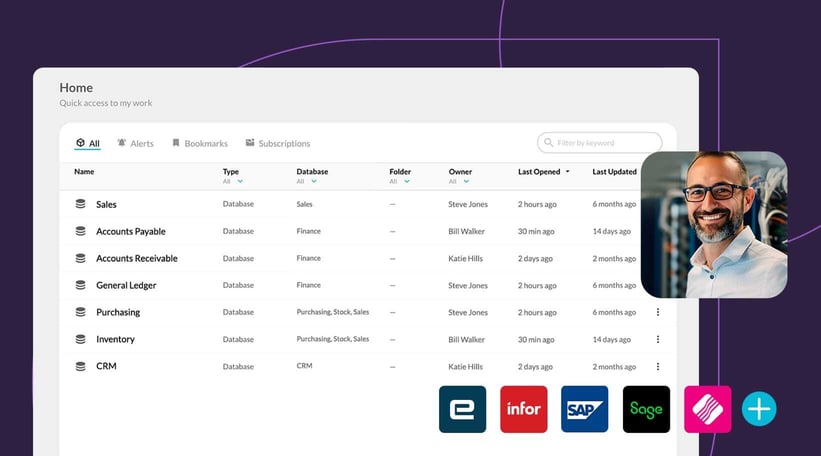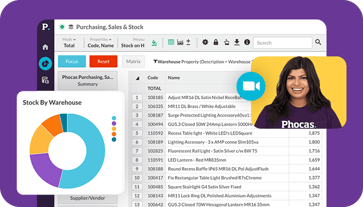How to integrate multiple ERP systems
Enterprise resource planning (ERP) systems are at the core of operational success. They help manage data and transactions across finance, your supply chain, human resources, procurement and sales. But for many organizations, the reality isn’t as simple as having a single ERP. Due to mergers and acquisitions, geographic expansion or divisional differences, companies often find themselves running multiple ERP systems. This way of operating comes with complexities as each system has its own functions, workflows and data formats.
This is where Phocas steps in, offering ERP integration capabilities that connect data from different systems into one actionable view. The BI and FP&A platform helps remove data silos and allows everyone to work from the same source of information.
Why businesses run multiple ERP systems
Running more than one ERP is more common than you might think. Here are some scenarios:
-
Mergers and acquisitions – When a company is acquired, both organizations may continue to operate their legacy systems for a time. One business might use Infor, the other NetSuite or Sage. Transitioning to a new ERP can take years making integration essential.
-
Operating in different countries – International operations often involve multiple ERPs due to localization requirements, regulations or existing on-premise solutions that suit specific markets.
-
Different divisions or business units – A manufacturing arm might use one ERP tailored to production, while the retail division uses a cloud-based ERP optimized for ecommerce and CRM.
-
Specialized functions – Some organizations deliberately run separate ERPs for distinct modules like human resources or procurement, especially if those functions require unique business intelligence and automation tools.
Challenges of multiple ERP systems
Managing multiple systems presents a range of challenges. One of the biggest issues is the creation of data silos. When each ERP system functions as a self-contained source of information, it becomes difficult to gain meaningful, cross-functional insights. This lack of interconnectedness limits visibility and makes it harder to see the full picture on performance or budgets.
Another challenge lies in the inconsistency of data formats. The fields, modules and workflows in different systems often do not align, which leads to mismatches and confusion when consolidating or comparing information. This misalignment can result in duplicated effort, data inaccuracies and increased complexity for teams.
Processes also tend to become time-consuming. Without a single source of data truth organizations often rely on manual consolidation through spreadsheets. This slows down access to real-time information and can delay decision-making, as teams must spend valuable hours gathering and reconciling data.
System disruptions add another layer of difficulty. An upgrade or ERP implementation in one platform may not automatically sync with others, creating inconsistencies and operational downtime. These disruptions can cause workflow interruptions and require extra resources to fix.
With lots of different systems scalability becomes tougher. Without an integration platform in place, adding new systems or expanding operations is complex and costly. Each new system introduces additional integration needs, making it harder for the business to grow while maintaining efficiency.
How Phocas integrates data from multiple ERPs
Phocas uses integration solutions that pull data from ERP software, CRM systems and other business intelligence sources into a single source of truth. Whether you run Epicor, NetSuite or Infor or a mix of cloud-based and on-premises systems, Phocas can connect them through APIs or connectors.
The integration process
-
System integration assessment – We identify your business needs, key stakeholders and data flow requirements across your ERPs.
-
Data mapping and formats alignment – We standardize formats so that modules and functions align across systems.
-
Automated data flow – Using automation and APIs, data from both systems flows into Phocas without manual data entry.
-
Real-time data access – Phocas syncs frequently, ensuring your business operations is based on the latest metrics.
-
Scalability and upgrades – Our integration platform accommodates future upgrades, new ERP adoption or adding more systems without redoing the whole process.
Benefits of bringing ERP data together
Bringing ERP data together through Phocas integration offers a range of valuable benefits for companies. One of the most significant advantages is improved operational efficiency. When data from multiple systems flows into a single platform, teams spend far less time on manual consolidation and can focus on higher-value activities such as selling, scenario planning and analysis. This shift not only saves time but also helps companies use their people and resources more effectively.
Better reporting is another key benefit. By automating data flows between systems, companies reduce the risk of errors from manual entry, speed up the reporting process, and ensure that modules across finance, human resources and operations remain aligned. This alignment supports more accurate and timely reporting enabling everyone to make informed decisions with confidence.
Phocas’ integration platform is also designed with scalability in mind. Whether a company is onboarding a new ERP, expanding operations into another country, or adding new SaaS tools, the system supports growth without causing major disruptions. This flexibility ensures that businesses can adapt quickly to change and pursue opportunities without worrying about system compatibility issues.
Integrating ERP data with other key systems such as CRM, ecommerce and supply chain platforms allows for powerful cross-functional insights. By bringing together these diverse data sources, companies can uncover opportunities for revenue growth, cost savings, and workflow improvements that were previously hidden within siloed systems. This holistic view empowers businesses to operate more strategically and competitively in their markets.
Whether you’re running legacy systems, juggling on-premises and cloud-based ERP software, or in the middle of a major ERP implementation, Phocas can help bridge the gap. By connecting your ERP systems from Epicor to NetSuite to Infor we give you real-time data, powerful business intelligence and a single source of truth to drive success.


Katrina is a professional writer with a decade of experience in business and tech. She explains how data can work for business people and finance teams without all the tech jargon.
Related blog posts

Most manufacturers, distributors and retailers run on enterprise resource planning (ERP) systems. These powerful platforms manage everything from finance to human resources and customer information. Yet, one of the most common complaints is how difficult it is to extract data from an ERP system. Without an automated way to pull ERP data, many companies resort to the same workaround which is dumping data into spreadsheets. While Excel is familiar and flexible, relying on manual spreadsheets is time-consuming, error-prone and makes it hard to maintain data accuracy. Businesses often need a better way to combine and analyze ERP data to build reports and streamline budgets.
Read more
Just as every cog and gear must turn with precision to be viable, a manufacturer has another necessary business tool, the ERP. Manufacturing operations were offered a digital boost in the 90s when enterprise resource planning (ERP) software came into use and the software continues to be relied on today for end-to end manufacturing management.
Read more
Phocas Software helps Sage customers gain more insights from their business Phocas Software, a business planning and analytics platform for sales, operations, and finance teams, announced a new technology partnership with Sage, the leader in accounting, financial, HR, and payroll technology. Phocas products are now integrated with Sage Intacct, making it easier for companies to access, analyze, report, and share information in their systems.
Read moreBrowse by category

Find out how our platform gives you the visibility you need to get more done.
Get your demo today